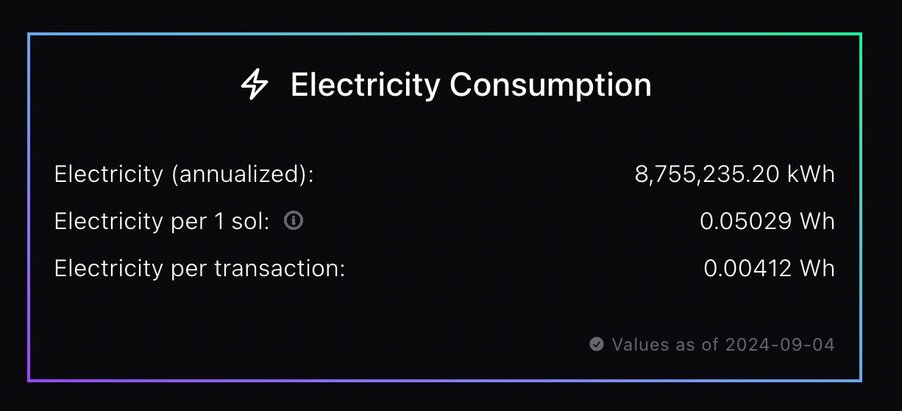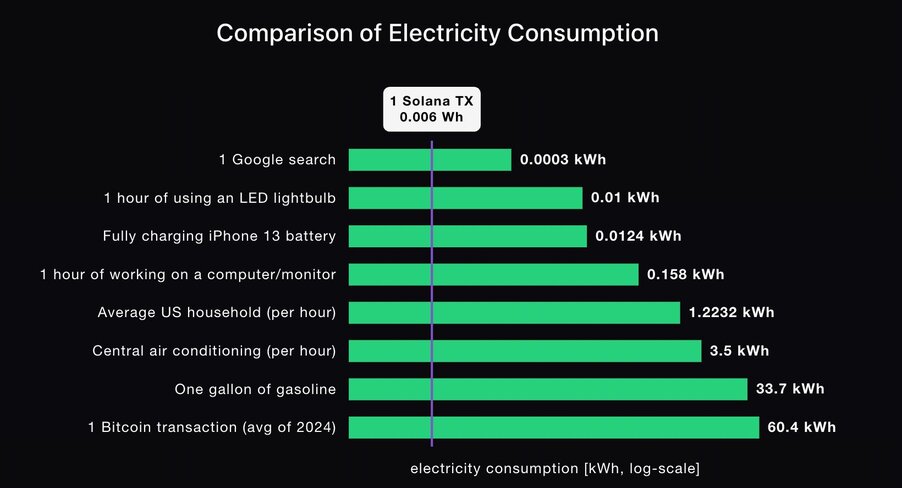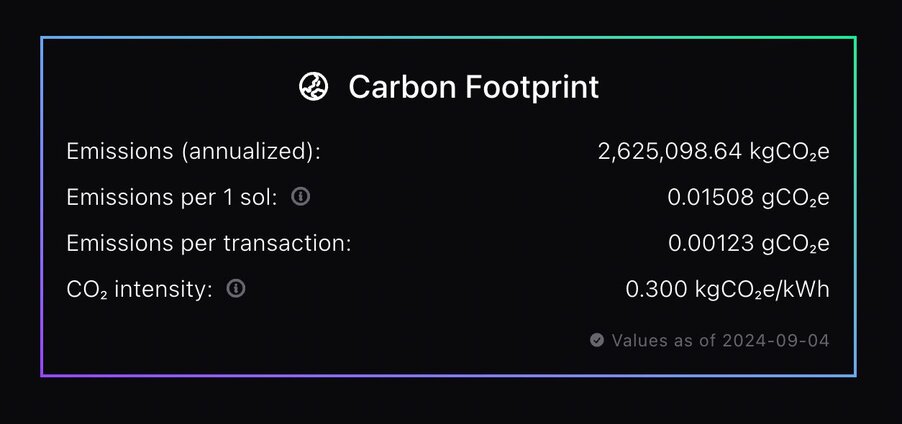Summary
As a proof-of-stake blockchain, Solana uses less energy than conventional proof-of-work networks. Less energy consumption means lower carbon emissions. Since the last Energy Use report in December 2023, the Solana network has reduced its carbon footprint by 69% through onchain purchase of carbon credits and innovative biodiversity credits.
Users can observe the network’s energy performance directly through a real-time emissions dashboard, recently updated to comply with new Markets in Crypto Assets (MiCA) regulations. These efficiencies, coupled with the Solana Foundation’s dedication to sustainability and a burgeoning decentralized environmental sector, make Solana a popular solution for environmental projects.
Introduction: Understanding Blockchain Energy Use
Despite the industry’s rumored reputation for high energy usage, not all blockchain networks are created equal, and the stereotype is generally not accurate. While an individual blockchain network’s energy impact can depend on a variety of factors — including size of the network, location of validators, and more — the one that most affects a blockchain’s impact is which consensus method it uses to maintain its ledger: proof-of-work or proof-of-stake. 1
Proof-of-work networks make participating computers compete to solve math puzzles. The winner updates the block and receives cryptocurrency as a reward. “Miners” use high-powered computers to outperform others, consuming massive amounts of resources. The network most famous for using proof-of-work is Bitcoin. From 2020 to 2021, Bitcoin mining used 173.42 terawatt hours (TWh) of energy, emitted more than 85.89 Mt of CO2, and used more water than the 300 million people living in rural Sub-Saharan Africa. 2
Proof-of-stake, a newer mechanism, avoids this resource-intensive competition by choosing a validator at random. Each validator stakes cryptocurrency as collateral for its performance. Quick, accurate block validation earns tokens. Computers can validate these kinds of transactions with little RAM. Some examples of proof-of-stake networks include Solana and Ethereum v2.
Solana takes this efficiency even further, pioneering several innovative mechanisms to process more transactions with less information. One of these is proof-of-history (PoH). Each block carries a timestamp—a hash of the current and previous block—that arranges blocks in chronological order. A computation called a Verifiable Delay Function confirms that the stamps reflect expected timeframes for addition to the chain. This allows validators to approve a transaction without re-verifying the entire block, reducing processing time and power.
Proof-of-history, alongside other innovations such as Turbine block propagation, allow Solana to process transactions in parallel, or processing multiple transactions at once — a unique design that means expending less resources per transaction. The Solana network can process more than 50,000 transactions per second in an energy-efficient way.
Energy usage can be measured in:
- A kilowatt hour (KWh) represents one Kilowatt of electricity expended for one hour. For example, a 100-watt light bulb would take 10 hours to use one kilowatt-hour of energy. The average dishwasher, a 1000-watt appliance, uses about a kilowatt per hour. 3
- A megawatt (MW) equals one million watts, enough to power about 330 homes for one hour. Producing enough energy for a MWH takes approximately 1,100 pounds of coal, or a wind turbine spinning for 30 minutes. 4
- A gigawatt (GW) equals one billion watts, and a terawatt one trillion watts.
Evaluating the Solana Network’s Energy Use
As part of its commitment to the strength and resiliency of the Solana network, the Solana Foundation tracks the energy usage of the network. Most recently, this data has been shared more broadly in a publicly-accessible dashboard. The dashboard is currently maintained by the Crypto Carbon Ratings Institute, a research-driven company that tracks this data for several blockchain ecosystems.
As of a snapshot on 4 Sept. 2024, the Solana network’s energy consumption in 2024 is projected to total 8,755 megawatt hours (MWh), about the same as the electricity used in 833 American homes. 5 The average energy usage per transaction is 0.00412 watt hours (Wh). (For comparison, Bitcoin uses about the same amount of electricity as 15,219,047 American homes).

Source: climate.solana.com
If we are to compare the energy consumption of a Solana transaction to other energy uses, such as using an LED lightbulb or central air conditioning, there is a clear view of how little energy each transaction uses. A single transaction on Solana requires about the same power as a single search engine query.

Source: climate.solana.com
The table below compares the energy use of popular blockchains. 6
| Blockchain Network | Annual Energy Consumption |
| Solana (PoS) | 8,483,906 kWh (8.482 mWh) |
| Bitcoin (PoW) | 159,800,000,000 kWh (159.8 TWh) |
| Filecoin (PoS) | 12,267,154.8 kWh (12.267 mWh) |
| Ethereum (PoS) | 5,024,983.6 kWh (5.024 mWh) |
| Dogecoin (PoW) | 3,800,000,000 kWh (3.8 TWh) |
| Avalanche (PoS) | 563,917.9 kWh |
| Polygon (PoS) | 121,536.9 kWh |
Solana’s Carbon Footprint
Since the last Energy Use report in December 2023, the Solana network reduced its carbon footprint 69%, from approximately 8,786 tCO2 in 2023 to an estimated 2,671 tCO.2 in 2024. That’s roughly equivalent to the annual carbon production of 167 Americans, who each produce about 16 tons of carbon dioxide each year. 7 The figures below detail the Solana network’s carbon impact.
While carbon footprint provides a snapshot of a company’s overall environmental impact, more detailed insights come from carbon intensity, the amount of emissions per unit of economic output. This figure allows comparison of different activities within an industry. One common measure of carbon intensity calculates the amount of carbon generated per kWh.
Processes powered by cleaner energy sources like wind and solar energy will have a lower carbon intensity value than those reliant on fossil fuels. Examining emissions at this level helps the Solana Foundation make smart decisions about efficiency, scale, and carbon offsets. The graphic below captures the Solana network’s carbon impact.

Source: climate.solana.com
Offsetting the Network’s Impact
In order to make the Solana network sustainable and minimize stress on the environment, the Solana Foundation takes a number of steps to offset the network’s impact.
For 2023, the Solana Foundation achieved these footprint reductions with blockchain-based carbon offsets through EcoToken, a platform that helps make small environmental projects economically viable. For 2023, the offsets the Foundation purchased are being used to support planting trees in urban areas in North America.
In addition to carbon credits — a well-known offset option — the Solana Foundation is also working with Terrasos to experiment with a new form of offsets called biodiversity credits. These credits preserve one square meter of ecologically sensitive land for up to 30 years. Terrasos uses Solana to integrate program governance, asset management, and ecological data onchain. Learn more here.
In addition, the Solana network’s public dashboard has undergone updates to reflect new Markets in Crypto Assets (MiCA) regulations, including a dedicated page to the data. MiCA, a regulatory framework developed by the European Union, becomes fully applicable in December 2024.
Beyond the work of the Foundation, the Solana ecosystem has become a decentralized network of choice for environmental projects and has a thriving ReFi (regenerative finance) ecosystem. Some projects include:
- GainForest, a Swiss tech non-profit organization dedicated to reforestation efforts that uses Solana to manage and track donations;
- Sunrise Staking, which allows users to donate staking rewards as carbon offsets;
- Outerverse, an outdoor-themed NFT marketplace; and
- WiHi, Winner of the 2022 Solana Summer Camp Hackathon Climate Award, offers decentralized enhancement for weather forecasting and climate monitoring by incentivizing users to provide sensor data.
The Solana Foundation will continue to report on the impact of the Solana network. Feedback is welcome here.
Footnotes
- https://www.bitwave.io/blog/explained-proof-of-work-vs-proof-of-stake-carbon-footprint
- https://agupubs.onlinelibrary.wiley.com/doi/full/10.1029/2023EF003871
- https://electricityplans.com/kwh-kilowatt-hour-can-power/
- https://www.carboncollective.co/sustainable-investing/megawatt-hour-mwh
- The average U.S. household consumes about 10,500 kilowatthours (kWh) of electricity per year, according to the U.S. Energy Information Administration. Source: https://www.eia.gov/energyexplained/use-of-energy/electricity-use-in-homes.php
- Source: https://indices.carbon-ratings.com/
- https://scied.ucar.edu/learning-zone/climate-solutions/carbon-footprint
Unchain Crypto with Blinks and Solana Actions
Mint, swap, sell, vote, and process any Solana transaction — from anywhere. Start building blockchain links and Solana Actions today.